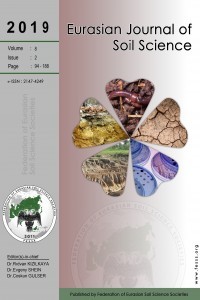
Eurasian Journal of Soil Science
Yazarlar: Justin George KALAMBUKATTU, Suresh KUMAR, Yogesh S. GHOTEKAR
Konular:-
DOI:10.18393/ejss.427189
Anahtar Kelimeler:Soil quality,Himalaya,IDW interpolation,Watershed,Soil organic carbon
Özet: Soil organic carbon (SOC) is a key component in maintaining soil quality. Mapping the local scale variations in the distribution and stratification of SOC and other soil quality parameters across different layers has always been a challenging task, in the current global scenario of changing climates. The study was aimed to investigate the spatial distribution of SOC and other soil quality parameters including SOC stratification ratio and CN ratio in a small hilly watershed (̴ 10 km2) located in the mid Himalayan region of Himachal Pradesh, India. Soil samples were collected in November 2015, from 75 points at two depths (0-15 cm and 15-30cm), along with their geographical coordinates using a Global Positioning System (GPS). The results revealed that SOC concentration (g kg-1) decreased with increasing soil depth, throughout the study area and differed significantly (P<0.01) between the two depths in vertical soil profile. The SOC stratification ratio values were greater than 1.2 in major portion of watershed indicating a spatial improvement in soil quality. C: N ratio, another important soil quality attribute values were found to be <12:1, indicating high degree of soil quality and increased rate of organic matter mineralization. The spatial distribution maps of SOC content (g kg-1), SOC stratification ratio as well as CN ratio of study area were generated using Inverse Distance Weighted (IDW) interpolation approach. Additionally soil quality index (SQI) was also computed using various soil quality parameters based on Analytical Hierarchy Process (AHP) and their spatial distribution was analyzed in the watershed. Nearly 76% of the study area had SQI values in the range of 60-75, whereas 22.16% of the area had SQI<60 and 2.59% had SQI>75. The overall results indicated that a higher degree of soil quality existed at the higher elevation regions of the watershed. Majority of the soils in the watershed accounted for only 60% of the maximum possible value of SQI, which necessitates the adoption of better management practices for improving the soil quality.